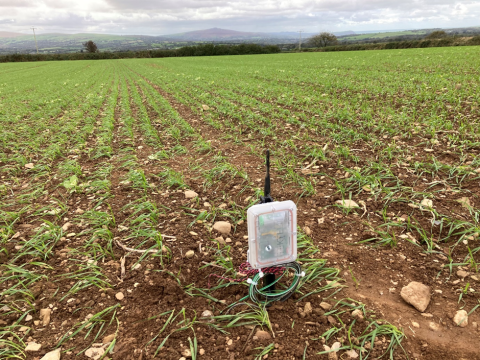Pantyderi Project Introduction: Using LoRaWAN connectivity to monitor real-time soil nitrate levels in a winter wheat crop
Site: Pantyderi
Technical Officer: Delana Davies
Project Title: Using LoRaWAN connectivity to monitor real-time soil nitrate levels in a winter wheat crop
Introduction to the project
Nitrogen (N) is the most influential controllable yield component in most arable production systems. It is found in multiple forms in the soil, with nitrate (NO3) being the form of nitrogen most easily taken up by the plant. During the period of rapid growth and nitrogen uptake, to reach optimal yield, the corn crop must have an adequate supply of available nitrogen in the soil every day.
A limitation of laboratory nitrate testing is that the test is only a snapshot of the nitrate levels in the soil at that exact moment in time. Nitrate levels can also fluctuate widely due to water movement, denitrification, mineralisation, crop uptake and other factors.
Both economic and environmental benefits could be realised through having a fuller knowledge of soil nitrate levels and their changes over time. Economically, fertiliser cost savings can be made by avoiding nitrogen applications in excess of crop requirements, and environmental gains can accrue by reducing the potential for nitrate movement into ground water through avoiding over-application of nitrogen fertiliser.
Aim of the project
The aim of this project is twofold:
- To explore the use of the existing LoRaWAN gateway at Pantyderi Demonstration Site to collect and monitor real time soil nitrate readings. The project will link into an Innovate UK project developing the use of soil nitrate sensors, based at the John Innes Centre in Norwich.
- To build a database of information on real-time levels of soil nitrate and their changes over time relative to soil temperature, rainfall, crop growth and development, thereby enhancing knowledge on potential measures to increase efficiency of nitrogen use in the growing crop.
What will be done
The trial field is an 8ha field, sown with winter wheat that has previously grown a
bi-crop of peas and beans. Being a pulse crop, this crop supports nitrogen-fixing nodules on its roots, which have a symbiotic relationship with the host plant, deriving carbohydrate from it and supplying nitrogen in return. No nitrogen fertiliser was used to grow the peas and beans, and residual nitrogen will also be left in the soil for use by the winter wheat crop.
Three sets of nitrate sensors, together with temperature and moisture sensors, will be installed at the top, middle and bottom of the field. Data recording will continue from the end of October through to crop harvest in July.
Every treatment applied to the field, in terms of any fertiliser, herbicides, insecticides, fungicides, and growth promoters, will be logged. Soil samples will be taken regularly for nitrate sensor calibration. NRM Soil N-Check Plus analysis will be done in April for nitrate N, ammonium N, calculated soil mineral nitrogen (SMN), organic matter, estimate of mineralisable N, soil N supply and SNS index. A standard commercial leaf-nitrogen analysis will be carried out monthly from March onwards.
Set of soil nitrate, temperature and moisture sensors installed at Pantyderi

